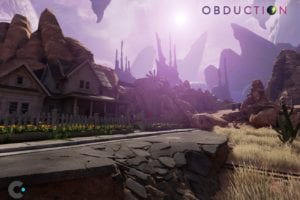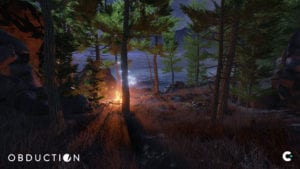Note: This review is based on the PS4 version of Obduction released August 29, 2017. Obduction was originally released for PC in August 2016 after being successfully funded through Kickstarter.
This review is being written after approximately 10-12 hours of gameplay.
____
There’s a reason that Myst was one of the best selling computer games of all time. It had intrigue, deep and complex puzzles, interesting visuals, and just enough story to keep the player moving forward. Obduction, the newest game from Myst creator Rand Miller and developer Cyan Worlds, is a spiritual successor in every sense of the term to its great and well-loved predecessor, Myst.

The Set-up
Obduction starts with the player standing in a forest next to a lake at night. A lightning storm brews in the distance while a staticky female voice-over talks about how she and others first encountered the bright light shooting across the sky. As the player moves forward, the bright light appears to them as well. The voice-over continues, revealing details and reactions of the people who also saw this light until eventually the voice-over ends and the player encounters the brilliantly lit object up close and personal. The world fades into a mass of sparkling colors and suddenly…
The player is somewhere new, in a daylit canyon with the seed of the bright light lying open before their feet. Journeying forth they encounter a holographic recording of a man welcoming them to a place called Hunrath. The area is desert-like, with cliffs and rocky structures and sparse plant life. In the near distance sits something that surely doesn’t belong: A small house with a white picket fence and the slab of concrete and asphalt it originally sat on. And beyond that, an other-worldly horizon, featuring a strange and mysterious alien landscape of purple and black and red. This is the world of Obduction.

Gameplay
Obduction is very much like playing Myst, but for the sake of those who have never played Myst, we highly advise stopping immediately and experiencing that masterpiece. In any event, the gameplay is simple. The player is free to move around in the typical fashion, using the right stick to move and the left to look around. Clicking the left stick enables the player to run and move much more quickly (basically a necessity as the walk is a very slow walk indeed).
Those that prefer a more traditional Myst-like experience can adjust movement to more of a point and click style, but otherwise, the player is free to move about as they so choose. A clearly visible cursor (moved with the left stick) can be used to select certain objects and manipulate switches and more by pressing X. Additional instructions for manipulating items will appear on screen as needed. Other than that, the player is set loose to figure out what comes next.
The interesting part of games like Myst and Obduction is that there’s an important element of gameplay that doesn’t take place in the actual controls of the game: Identifying important pieces of information and remembering them or keeping a detailed journal of one’s travels (this reviewer always recommends keeping a journal).
Obduction is a world of secrets and clues, hints and information, and it’s up to the player to determine what information they will need to figure out an obscure code later in a game or the proper way for making a bridge appear.
That’s what can make games like Obduction and Myst so very difficult.
A warning to any who wishes to dabble in these worlds: they will test one’s mind fully.
And that is part of what makes these games so engaging.
They aren’t easy, they don’t hand themselves to the player, and the require genuine reasoning skills and recall to successfully navigate. So when it comes to a Cyan Worlds game, always take in as much information as possible.
Story
The last, and one of the most key, elements of gameplay is the story. Typically, the story is how that game moves forward. But the story is typically leading the game and is not dependent on the player to understand that story. This is another one of the key elements of successfully completing a Cyan Worlds game, because there is always a point in which the player will have to make some sort of choice, and the success of that choice will depend on how well one understands what exactly is going on. That said, the basic story will be there for the player, but often times the greater details of the story will be learned through finding and reading books, journals, notes, and more spread throughout the game. As the player does not commonly encounter real-live people, this is usually the only way to discover a large portion of what exactly is going on.

The Technical
Obduction looks great. The worlds are fleshed out and interestingly and visually detailed, which makes exploring the game that much more engaging. This is something that Myst was always able to do, even in the early days of 90s computer gaming when the graphics weren’t all that great.
The music is slightly above average, but nothing special. Some issues do arise with movement though. The game has some laggy moments, which can be annoying, but fortunately aren’t too inhibitive. Only once did the game freeze to the point of crashing.It’s hard to tell if these things are because the game was originally developed for PC and someone just didn’t take the proper amount of time to make it perfect for PS4 or what, but it is an unfortunate thing to have to encounter.
The load times can be a bit long at certain points, as well, which is a minor annoyance. Controlling the movement and the cursor can be a bit tricky to fine tune, but fortunately, there are options to adjust these things in the menu to better suit the player’s needs.

Thoughts and Evaluation
Obduction is fantastic for anyone looking to find that old Myst feel. It starts off a bit rough, perhaps partially due to it being on a console as opposed to PC, but it certainly picks up back into that familiar vein. The puzzles are complex, the world is interesting, and the backstory has some surprising twists and turns to it. There are plenty of things to find and evaluate for worth throughout.
Sometimes it can be very difficult to discern exactly what comes next or what should be done to advance, but that’s one of the things that makes Obduction a worthy successor. It can be hard, and it can be frustrating, but it is also incredibly rewarding when a puzzle is figured out or something is understood.
Fortunately, for those looking for a little extra help, there is a setting in the menu to turn on helpful hints, and fortunately in the age of the internet, if any puzzle proves too difficult or frustrating, one can find tips or walkthroughs online to aid them in their journey.
Overall, Obduction is great for fans both old and new. Hopefully, this will enable a continuation of this style of gaming from this developer, and, dare the reviewer hope to dream, perhaps even a return one day to Myst Island.
Obduction can be played on both PC and Mac, VR versions can be found on Oculus Rift and HTC Vive, and it was recently released on PS4 with a planned patch to make it available on PSVR.

